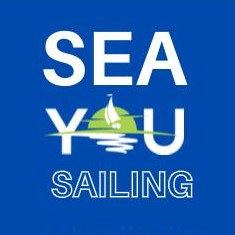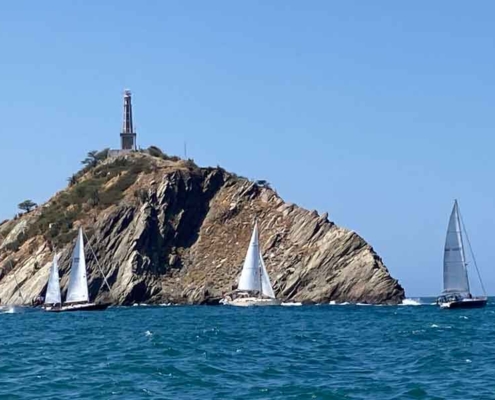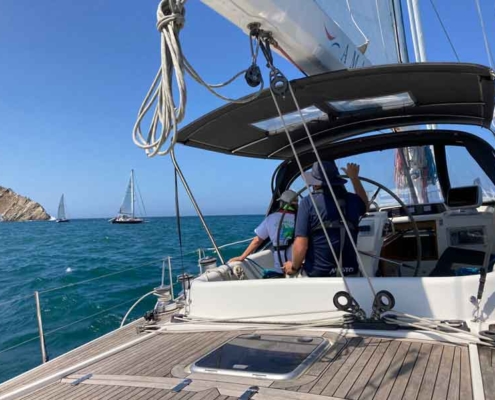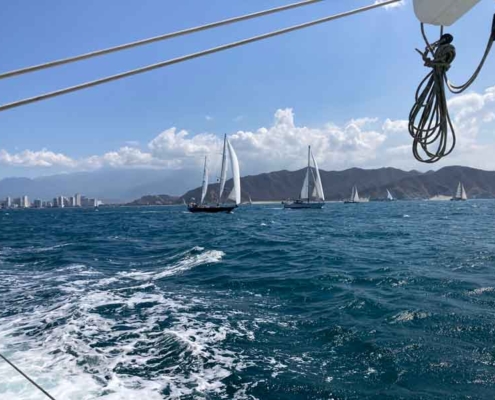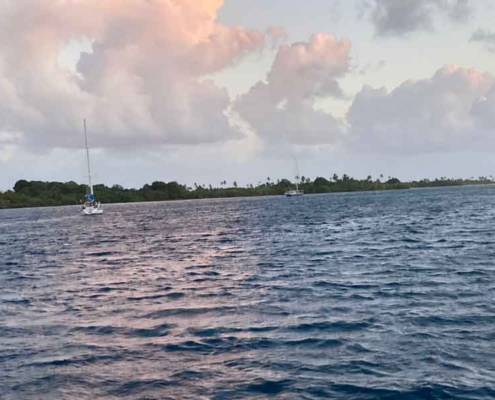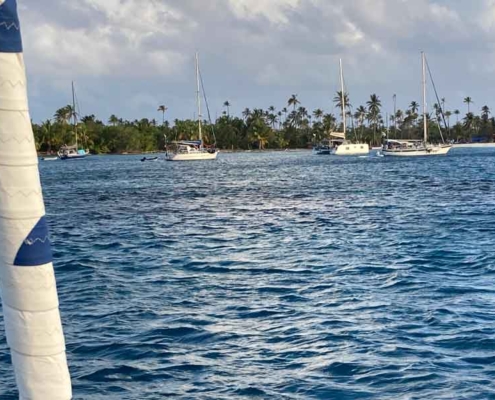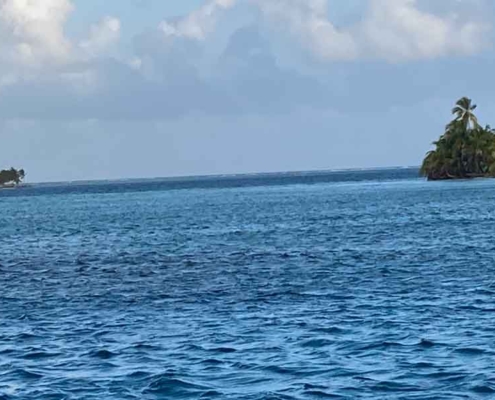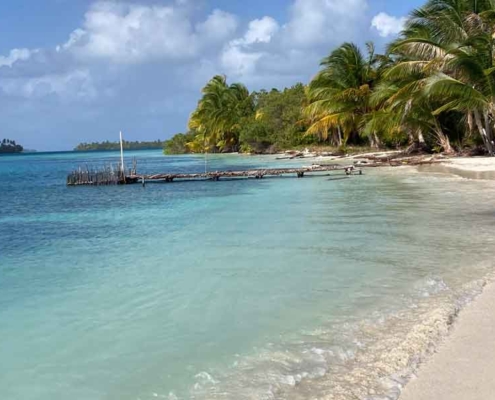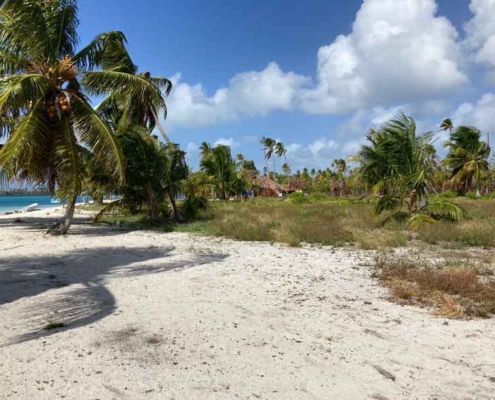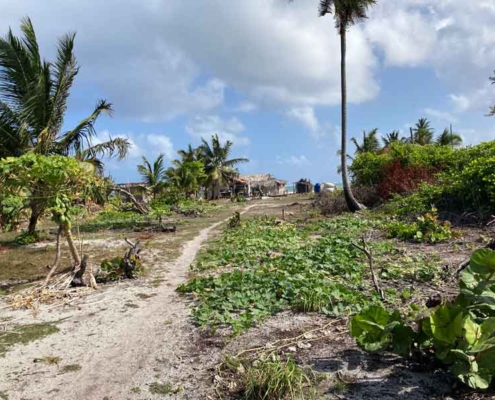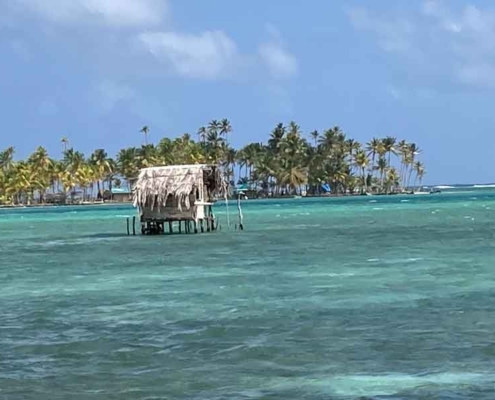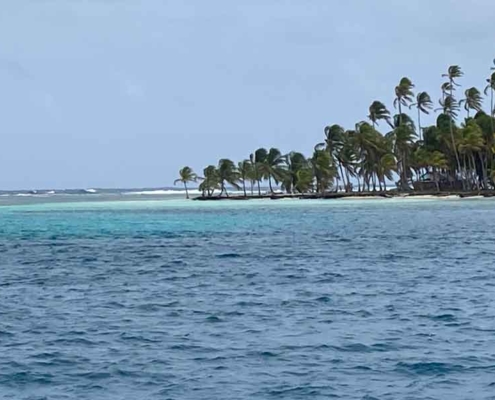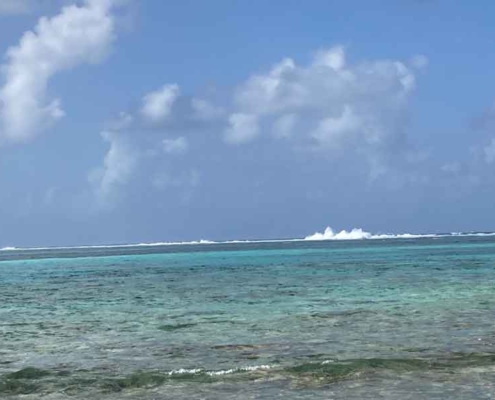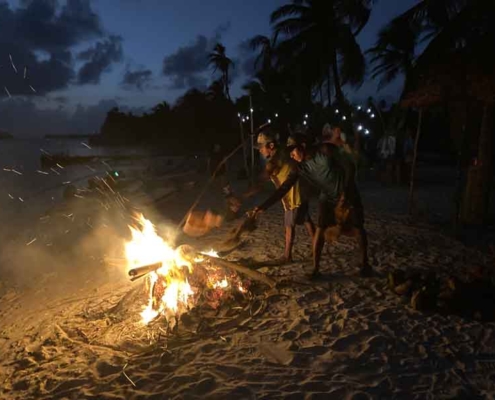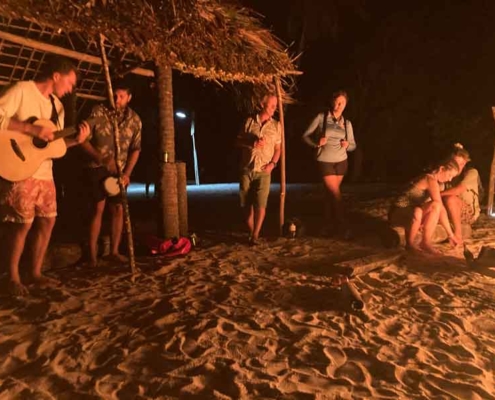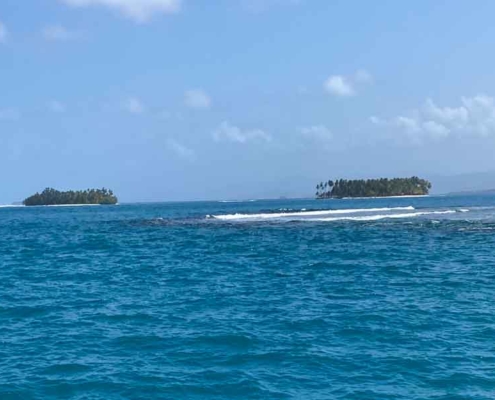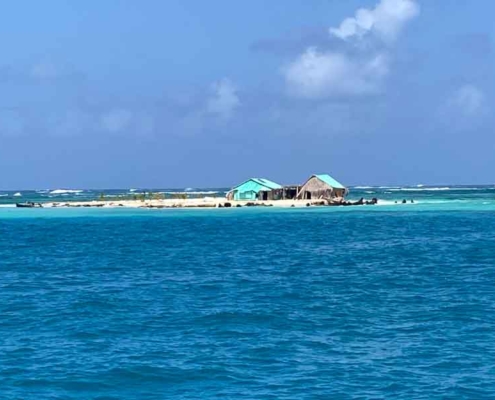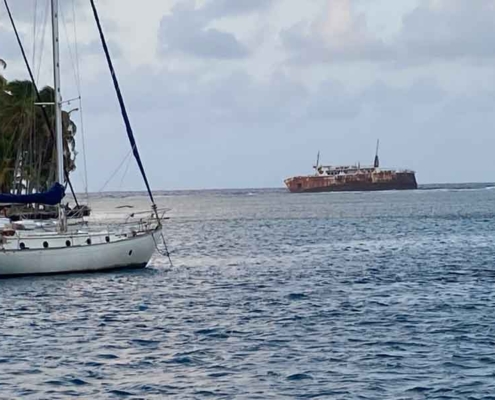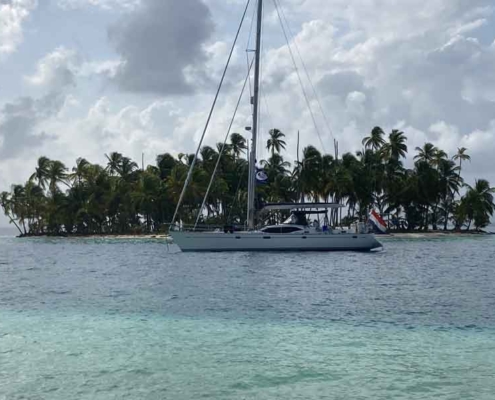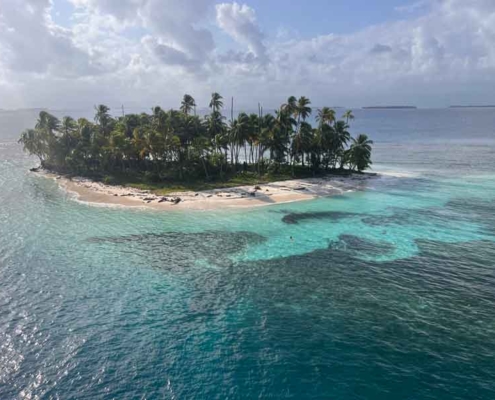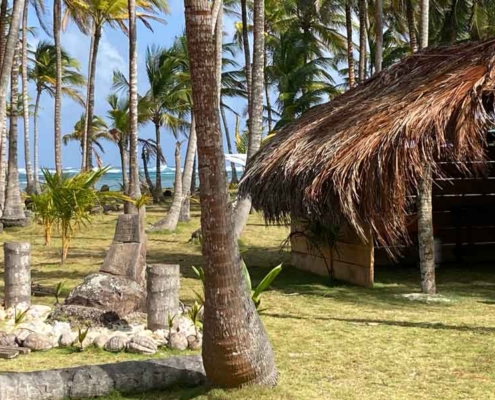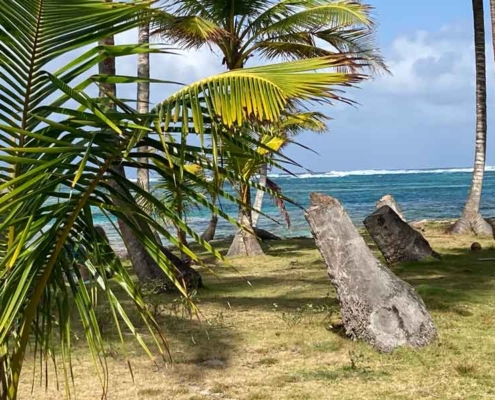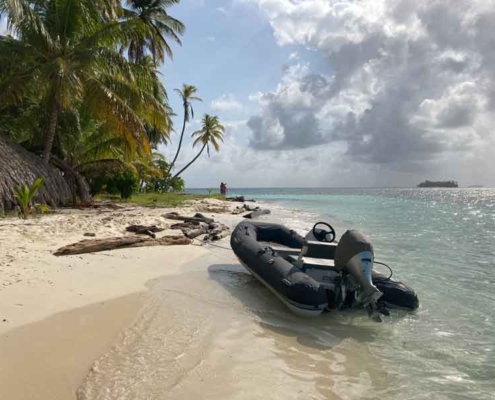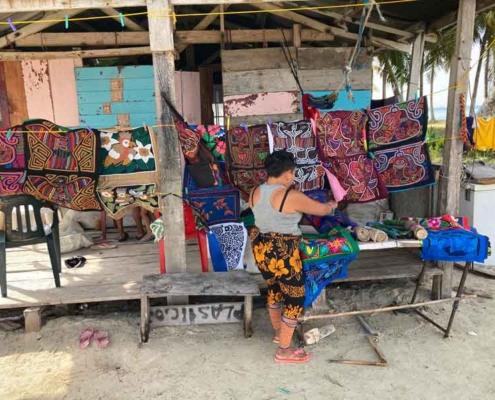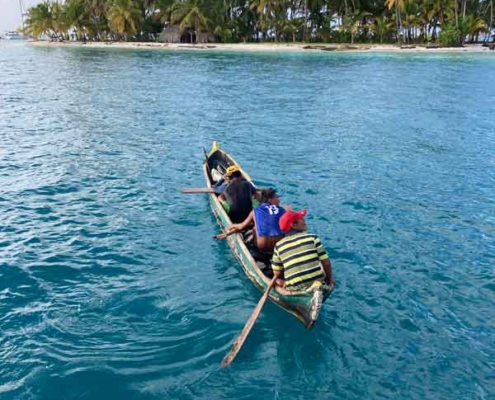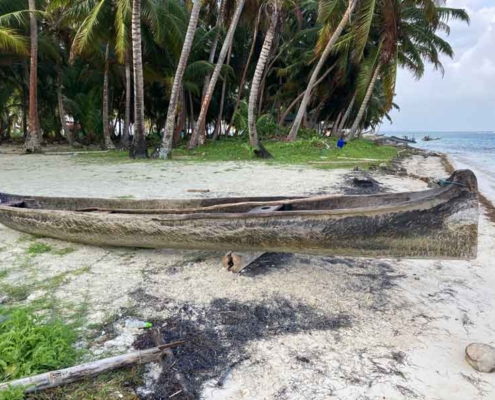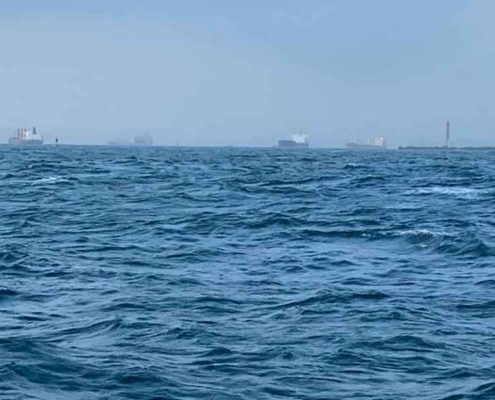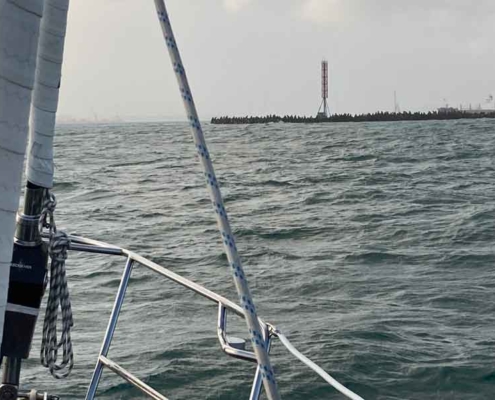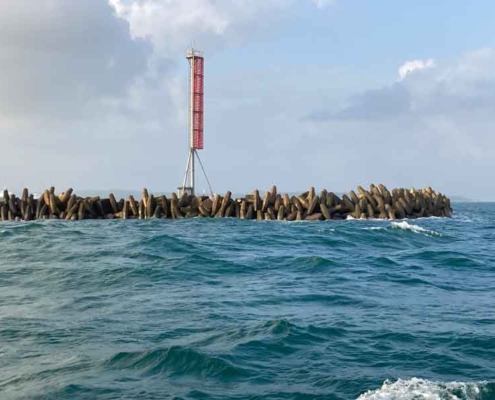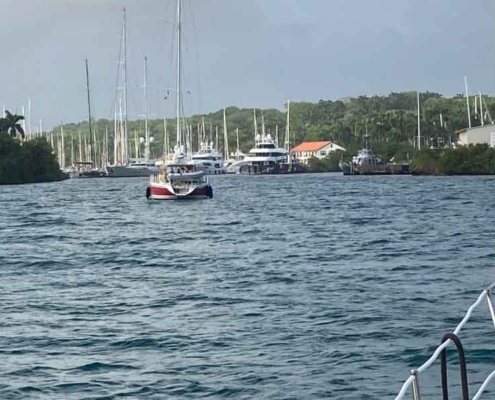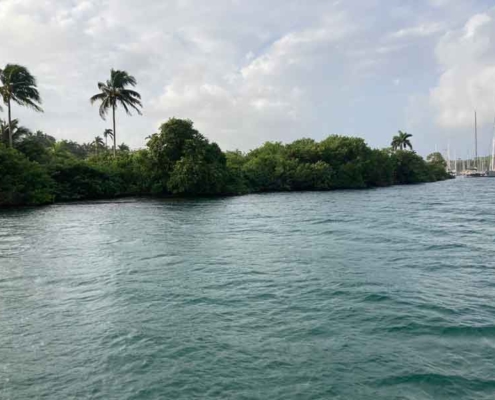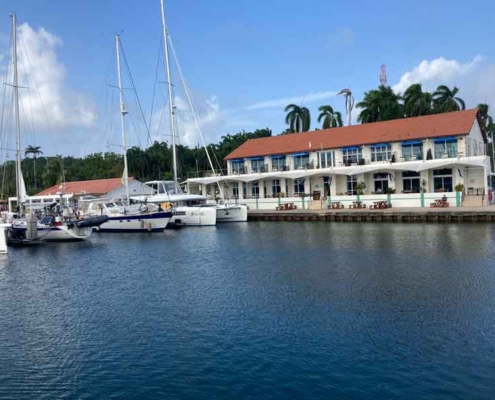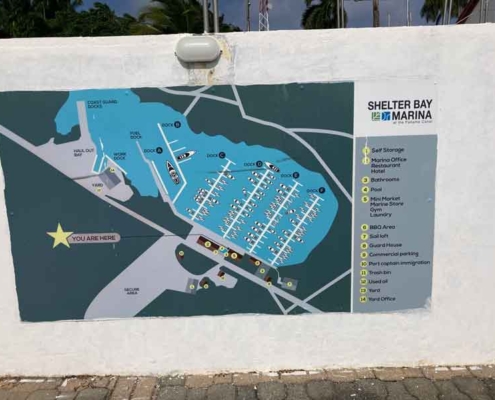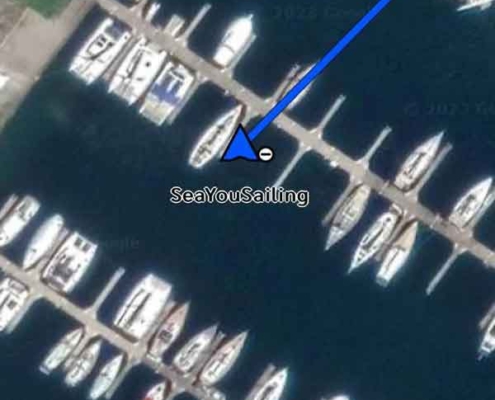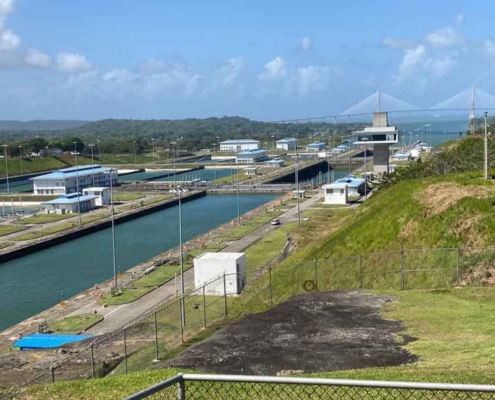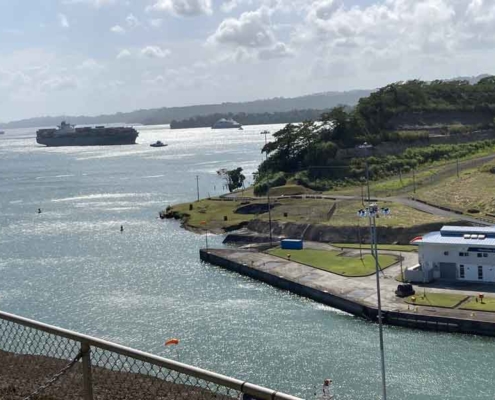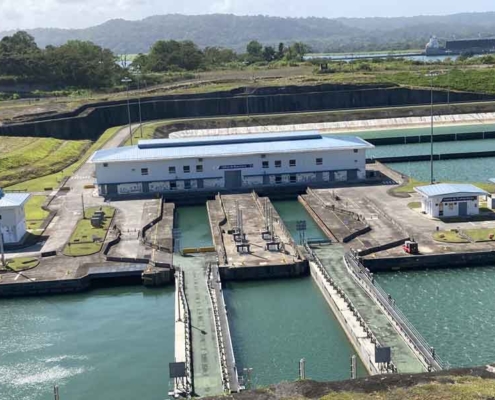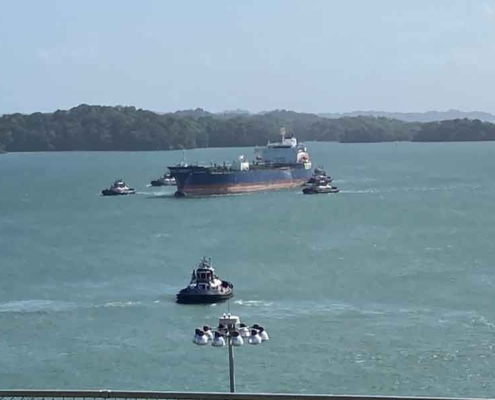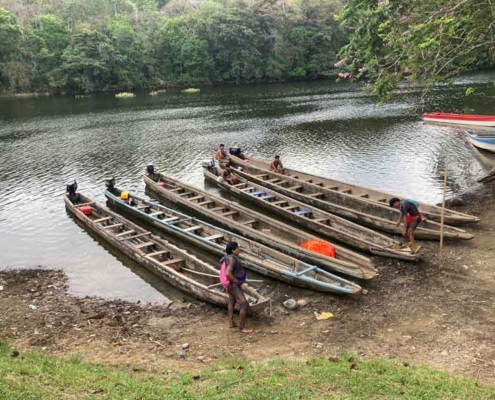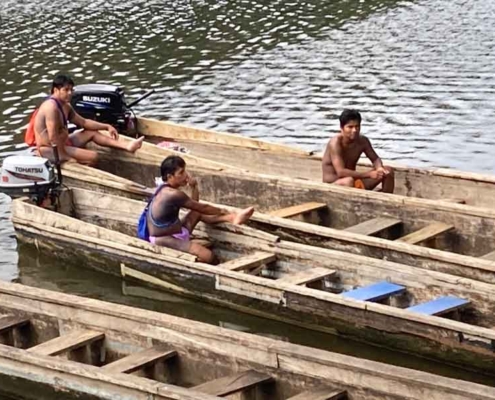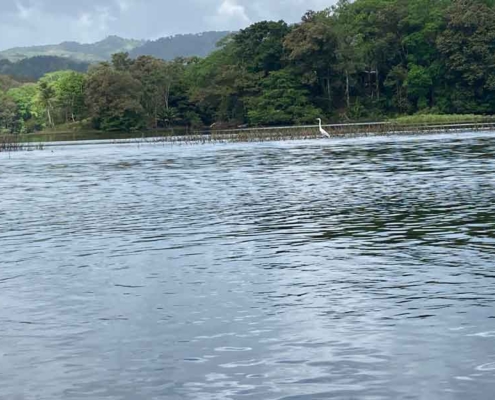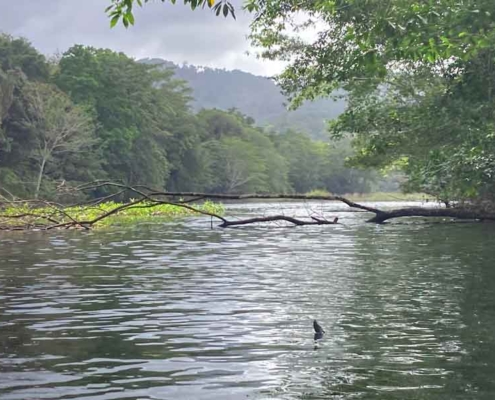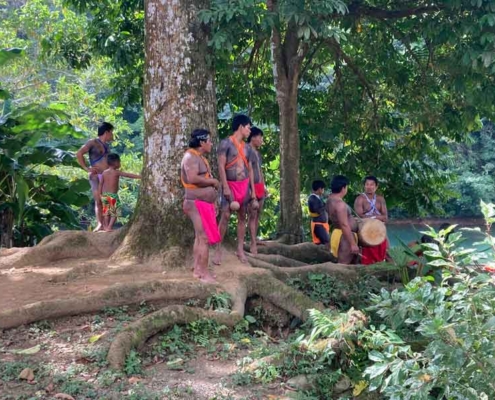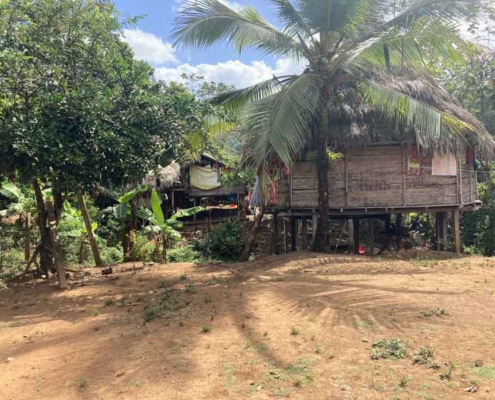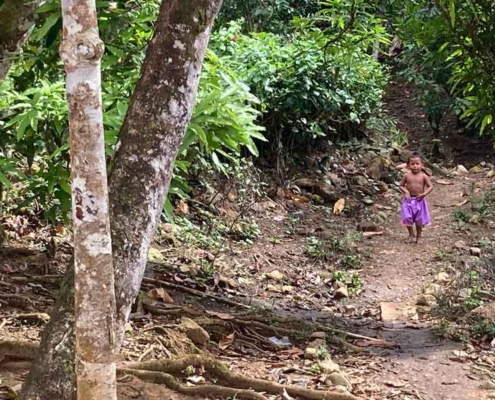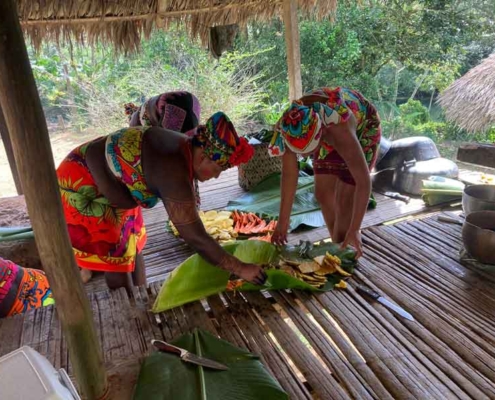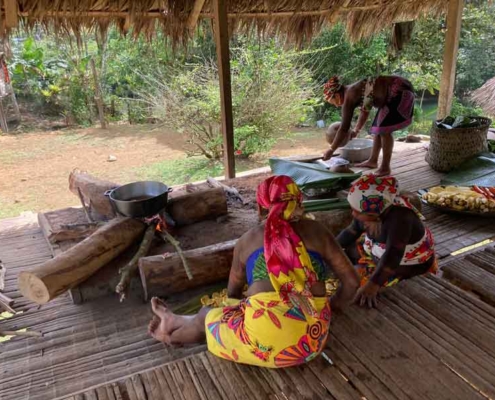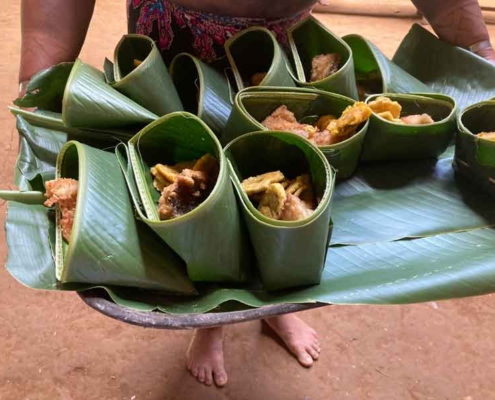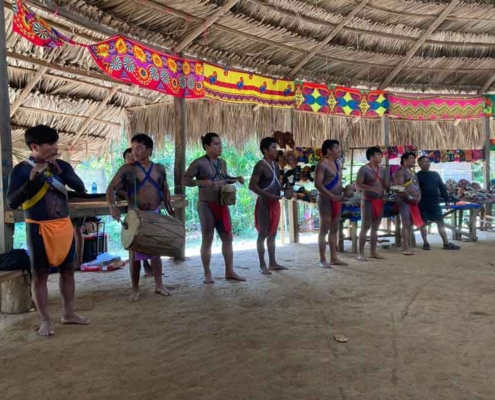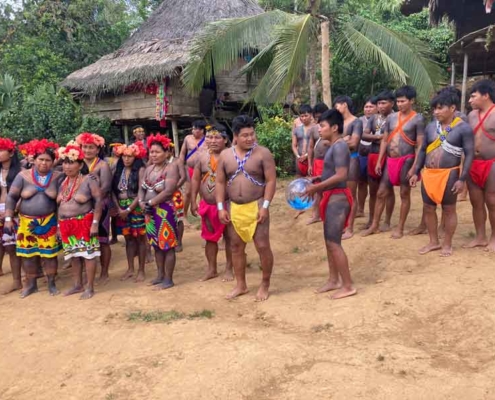Oyster 56; Amanzi; Sailing from Santa Marta, Colombia to the San Blas Islands, Panama; Januari 2023
Wednesday, January 18th, position 10:58.579N 75:25.855W
This morning at 12:00 was the start of the 2nd leg to the San Blas Islands. A short leg of 280Nm. A 36-hour sail according to our issued ETA estimate. By the way, that estimate was based more on a desired daylight arrival then on actual sailing time
The start was very similar to the previous one. We were one of the last to cross the starting line but with perfectly trimmed sails. In no time we had overtaken the entire fleet except levithian.
We were doing over 9kts SOG and very often even faster. The wind was also over 25kts. When it increased to 30kts, we put in the 2nd reef. Because of that we were overtaken by a number of boats. That was fine.. At this speed we might arrive the next day, but if the wind dropped, which was expected, we would arrive in the dark. That was not a good plan. There are quite a few reefs around the San Blas and the charts are not too accurate we had been told.
For now, we are still doing an average of 8kts SOG. Tomorrow morning we’ll see where we are then and possibly reduce some more sail to get our speed down.
Thursday, January 19th; position 09:46.353N 078:10.565W
Over the course of the morning, the wind decreased more and more. With only 13kts left, it was soon clear that we would not make it by daylight. We decided to reduce sail and aim for a Friday sunrise arrival.
It was a quiet day. The boat did roll quite a bit now and then. For a downwind course we were a bit underpowered. I was going to fry eggs for lunch. Just when I took out the box of 36 eggs from the cupboard, a big wave made the boat roll quite heavily .
I was able to limit the damage to 1 egg. A few more were broken but that was no problem. I was going to fry them anyway. The frying in itself was also quite a challenge but not worse than earlier on the Atlantic. Well, in the end it all it worked out fine and we had a tasteful lunch. The one egg that broke was cleaned up in no time.
Last night Marc and I alternated watches. Clare wasn’t feeling too well and preferred to stay below. This made it all the more noticeable that when Marc came on deck, the generator had to be switched on again to recharge the batteries. That was actually a bit too quick. They should hold longer than 3 hrs.
When I shortcutted the fan in the battery box, I had noticed that the batteries were from April 2015. So they are almost 8 years old and that could well be the reason they drain so quickly. Might be an idea to replace those in Panama City after all.
In the course of the day, the various boats came quite close together again. We are now sailing in a group of 5 boats towards the finishing line just east of the San Blas islands.
During the evening, the wind picked up a little. When I come on deck at 10pm it was blowing 20kts at times when a cloud passes over. We were doing almost 8kts SOG again with only 20Nm left to the finish line. Clearly we’re going too fast. I furled in the genoa even more but that didn’t help much slowing down. Finally I took all sail away and let her just drift.
We aimed for ‘Swimming pool bay’ at Cayos Hollandes or Islas Maqui as our anchorage. It is the northernmost island. During the last roll call, at least 10 other boats appeared to be heading for the same spot. The bay looks big enough on the map and pictures in the pilot book. We will see how accurate they are-:)
Friday January 20nd, Cayos Hollandes
After finishing we ‘drifted’ at 5kts SOG for over an hour to the west until we could steer to the passage between the reefs. By now it was 6am and starting to get light.
The passage wasn’t too bad in the end, but if you’ve never been there before you take the safe bet. Sarah of Sweden, Jorgen and Louise’s new boat had figured out that they could enter at night. They had been there before. Then they had run aground and uhh they ran that again this time. Fortunately without further damage.
At 7am we were anchored. Not in swimming pool bay but 1 bay south of it. That seemed a bit less rolly.
The San Blas islands are truly breathtaking. So different from the islands I had been before. Those all have volcanic origins. The San Blas originated behind large reefs, completely flat and also very tiny.
We took the dinghy to the small beach of the island we were right in front of. There was one hut there that served as a home and ‘restaurant’. We had lunch there. They don’t have a menu. They serve only 1 dish: fish with rice and something made of coconut. You get to fillet the fish yourself. What kind of fish I got, no idea but it tasted amazing!
After lunch, we walked to the other side of the island. That was a walk of about 3 minutes. There was the ‘real’ restaurant, consisting of a couple of huts. One served as a bar, another was for cooking a third was a canopy under which there was a large table and there was another large table a bit closer to the beach. We were given a very warm welcome by the owner who naturally asked us if we wanted to eat lobster at his place. We did and agreed to come back at 6pm.
We spent the rest of the afternoon sitting on the little beach where the dinghy was. Soon more dinghies arrived from the other boats that had anchored up. Just as quickly, the group that did want to join us for dinner grew. In the end, 11 of us settled there.
Once again, the food was fantastic. After a delicious ceviche as a starter, we got the freshest lobster you could think of. The portion however was adjusted to the number of people it seemed. The next day, the lobster was finished when other people wanted to follow our example. After the lobster, we had another very tasty dessert. It was an exceptionally successful evening.
Saturday, January 21st
The next morning, we went snorkeling. However, the bay where we were anchored turned out not to offer very much in that respect. It was mostly sand and patches of seaweed. Closer to the reef at the end of the island, the current was so strong that we decided not to enter the water.
Sometime during the day, we spoke to Alex from one of the boats who invited us to join the bbq on the beach. He had agreed with the locals that we could use the beach if we ordered drinks from them as long as supplies lasted. This, of course, was no problem. Besides, they would make a big bonfire for us. It was a fantastic evening in which almost all boats participated. With the exception of the people who vainly wanted to go and eat lobster. They went but got chicken. They hadn’t caught any new lobsters yet.
Monday Januari 23rd
On Sunday, we sailed on to the Coco Banderos. A group of uninhabited mini islands. It took some manoeuvring and then we anchored in a breathtakingly beautiful spot in the gully between two of the islets.
There were only a few other boats anchored there. The difference between the beach bbq with campfire and music of the night before and the utter peace and ‘quiet’ of this spot could not have been greater. And as beautiful as the first islands were, these tiny islets were additionally beautiful.
The next day, we sailed on again to Dog island or Isla Perro . There is a wreck there just a few metres deep and would be a nice snorkeling spot. It turned out to be. We were able to tie the dinghy to the buoy of the wreck and I used my GoPro underwater for the first time. That was a bit exciting because I don’t have a strap on it that I can tie around my wrist. I’ll have to look for that in Panama City. Along with also a stick because now I couldn’t really see what I was filming.
After the snorkeling action, we anchored at an island further out. That too was a bit exciting because the route to it was a kind of slalom between the reefs. The wreck of a large freighter and a sailing yacht lying on its side on the reef the reef looked ominous. All went fine thanks in part to the headsets that allowed Marc and I to communicate perfectly while he was helming and I was on a lookout on the foredeck.
Not much later, Voyager ll also entered the anchorage. For them, anchoring went a little less smoothly. Their anchor winch was broken and then 50m of chain is a bit much pulling in by hand if you are not satisfied with your spot. In the end, they anchored at a spot on the other side of the reef.
Marc then picked them up in the dinghy to have a drink with on our boat.
Tuesday January 24th; position 09:39.747N 79:36.472W
Today we sail on to Shelter Bay, Colon. We cannot get there until 8am because that is when they open. So it will be an overnight sail. Shelter bay is about 75Nm. If we can limit the SOG to 5kts, that’s 15 hours of sailing. Counting back, we should then leave around 5pm. That’s a good time to sail out of the reefs in daylight too.
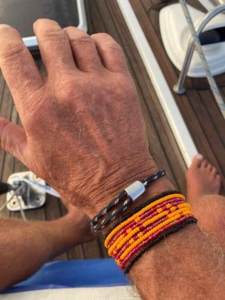 In the morning, we took the dinghy to the islet south of us. We had already visited the islet north of us when we arrived. These islets were just a bit bigger. The circular walk now took as much as 10 minutes. They were also inhabited and, of course, wholeheartedly willing to offer their handicrafts. I found a beautiful bracelet. I was fiddling with putting it on. When the woman I bought it from saw that, she immediately came over to help me.
In the morning, we took the dinghy to the islet south of us. We had already visited the islet north of us when we arrived. These islets were just a bit bigger. The circular walk now took as much as 10 minutes. They were also inhabited and, of course, wholeheartedly willing to offer their handicrafts. I found a beautiful bracelet. I was fiddling with putting it on. When the woman I bought it from saw that, she immediately came over to help me.
The first plan was to leave at the end of the morning and sail towards the coast and then go to Shelter Bay later. Later we decided to stay for a while anyway. Getting some sleep in the afternoon was also a plan as we would be sailing all night.
We left at 5pm with, incidentally, about five other boats that had by now anchored around the same islets.
So far, the night has been calm and with only a reefed genoa, speed is also good. The boat does roll quite a bit with so little pressure in the sail. Cooking again was a challenge and so was sleeping, at least for Marc. I had less trouble with that 🙂
Wednesday, 25 January: Shelter Bay, Colon, Panama
Exactly at 8 am we arrived at the marina. That timing was perfect but it wasn’t easy. The last bit we ran way too fast and I furl in the genoa almost completely -again – to get the speed out of the boat.
We arrived with 5 boats at the same time. This did cause a bit of stress for the manina staff who helped us dock but everything else went fine.
Shelter bay is where quite a few boats go out of the water to have the boat cleaned or repainted with antifouling. For the Galapagos, your boat has to be really completely clean or you won’t be allowed in. Until recently, you were sent back with a diver to clean your boat at least 25Nm off shore. That would cost you $1,800. From now on, you too will be fined $6,000.
Eggs and chicken, even if frozen, are also no longer allowed to bring in and even the soles of your shoes are assessed to see if they are clean enough,… well, whether all that is necessary, I cannot judge but it does seem very strict.
Exploring Shelter Bay
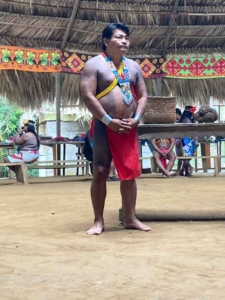 From Shelter Bay we took a tour to the new lock complex and the day after we visited we visited a village of the Embera Indians. That Indian village was quite an experience. First a bus drive and then half an hour in a large wooden canoe up the river.
From Shelter Bay we took a tour to the new lock complex and the day after we visited we visited a village of the Embera Indians. That Indian village was quite an experience. First a bus drive and then half an hour in a large wooden canoe up the river.
Once we arrived in the village, I did not feel very comfortable at first. We were welcomed with music but it felt very much like peeking.
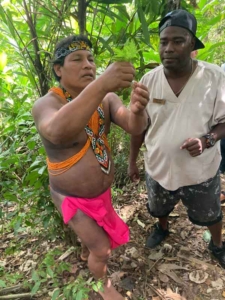 That feeling disappeared completely when we were given the explanation by the tribal chief. They live in the traditional way because they want it and like it. The government also gives them all the space they need and at some point suggested sharing that very lifestyle with visitors and thus earning an income. And that is exactly what they do. They talk about their history, about their daily life and they also dress in traditional ways because they want to share the authentic way of life.
That feeling disappeared completely when we were given the explanation by the tribal chief. They live in the traditional way because they want it and like it. The government also gives them all the space they need and at some point suggested sharing that very lifestyle with visitors and thus earning an income. And that is exactly what they do. They talk about their history, about their daily life and they also dress in traditional ways because they want to share the authentic way of life. 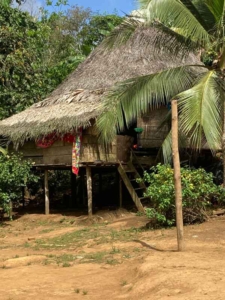 Everything is about education. From that perspective, I felt completely fine and it was a very educational experience. They were also very open about the challenges they face. Young people are free to choose to (continue to) live in the village or move to a place with the ‘modern’ amenities. Each is also free to choose a partner who does not belong to the tribe. We were also explained in detail about the objects and jewelry they make, materials, what they use as dye, the fabric they use to paint their skin which, by the way, works excellently as a repellent.
Everything is about education. From that perspective, I felt completely fine and it was a very educational experience. They were also very open about the challenges they face. Young people are free to choose to (continue to) live in the village or move to a place with the ‘modern’ amenities. Each is also free to choose a partner who does not belong to the tribe. We were also explained in detail about the objects and jewelry they make, materials, what they use as dye, the fabric they use to paint their skin which, by the way, works excellently as a repellent.
In short, a very informative afternoon that was actually too short.
